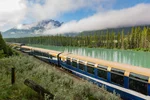Best Place in Canada to See Northern Lights
Churchill, Manitoba, is one of the best places in Canada to see the Northern Lights. These phosphorescent green, yellow and pink lights sometimes appear in northern skies at night. For centuries, travellers have been entranced by the phenomena of the aurora borealis. There are several places in Canada where you can see the Northern Lights, and winter, November to March, offers the best viewing.
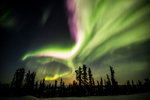
The team of local tracel experts at one of our other Canadian travel sites — Northern Lights Canada — can help plan your aurora borealis vacation. Travel to Manitoba, the Yukon, or the Canadian Rockies for this once-in-a-lifetime experience. Spend the daylight hours doing exciting winter activities, like dogsledding or snowshoeing. In the evening, head to remote locations for guided lights viewing. All our Canadian Northern Lights tour packages are customizable to your interests. We take care of your hotels, transportation, and activities.
Where to see the Northern Lights in Canada?
Canada has several top destinations for Northern Lights viewing. You could catch the lights in any Canadian province, but your chances increase when you head north. The below list features our favourite places in Canada for seeing the Aurora. Much of Canada’s north can be hard to access, so we’ve only listed the easiest places to reach.
The best time to see Northern Lights in Canada is between late August through April. The longer, dark nights of Fall and Winter means the window of time for viewing is extended. In addition, the colder weather means there is a higher chance of clear skies in northern latitudes — the cold air holds less moisture — increasing the odds of seeing the aurora borealis.
The Northern Lights forecast is a great tool that you can use to track the intensity of the aurora over your travel days.
[ Explore: Northern Lights Canada Tours ]
1. Churchill, Manitoba
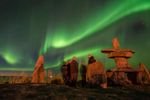
Churchill is the best place to see the Northern Lights in Canada. The town sits under the auroral oval, and the Northern lights are visible up to 300 nights annually. Long nights and cold temperatures offer the best experience for witnessing auroral activity, so we recommend visiting during January, February or March.
Located on the shores of Hudson Bay, Churchill is also a hotspot for polar bear viewing in the fall and beluga whale viewing in the summer. You may see the lights during these seasons, too.
Best time to go: January, February, and March
Number of nights visible: up to 300 nights per year
Tours and daytime activities: Wildlife tours (including polar bears and belugas, depending on the season), astronomy tours, tundra-buggy excursions, photography courses, dog-sledding, snowshoeing, Indigenous story-telling and experiences, fine-dining options, and museums.
#1 Travel tip: Daytime activities
Northern Lights viewing happens late at night, so there’s time for fun activities during the day. You can choose to go dogsledding, snowshoeing, snowmobiling, and more.

2. Yukon
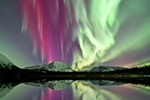
The Yukon is one of Canada’s northern territories and a top destination for Northern Lights viewing. The beginning of winter provides the highest probability of seeing the aurora borealis, though it is possible to spot the lights anytime from August to April. Like Churchill, visiting in winter is best as the nights are long and dark with clear skies. The lights appear brighter when there is a dark sky.
In the summer, the Northern Lights are not visible in the Yukon because of the midnight sun.
Best time to go: between November and March
Number of nights visible: up to 240 nights per year
Tours and daytime activities: Wildlife tours, fall-colour tours, hot springs and spas, dog-sledding, snowshoeing, museums, Indigenous story-telling and experiences, glass-blowing courses and art gallery tours.
Also read: Northern Tales in Yukon
3. Canadian Rockies
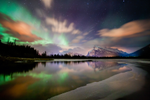
The Canadian Rockies are famous for dramatic mountain peaks and turquoise lakes, but did you know that you can see the Northern Lights here, too? Jasper and Banff national parks are two of Canada's best locations for Northern Lights viewing.
Banff National Park is home to many recommended locations far from city lights that are perfect for visitors chasing the Northern Lights. Cascade Pond offers clear views to the northern horizon, while Lake Minnewanka’s large size provides ideal open skies.
Jasper is the world's second-largest Dark Sky Preserve. Dark Sky Preserves are areas with low light pollution. So, Jasper is the perfect place to stargaze and watch the Northern Lights. You can visit Jasper during the Dark Sky Festival in October for an even more magical experience.
Best time to go: between October and April
Number of nights visible: up to 300 nights per year, depending on light pollution
Tours and daytime activities: Wildlife tours, hot springs and spas, dog-sledding, snowshoeing, museums, Indigenous story-telling and experiences, gondola tours, planetarium and museums.
Explore: Canadian Rockies Train Trip
4. Newfoundland and Labrador
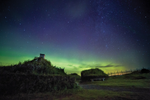
If you are on the East Coast of Canada, head to Newfoundland and Labrador to see the Northern Lights. Your best bet for viewing the Aurora in this province is to find a remote spot away from light pollution. There are some great viewing spots near the coast, in the national parks, and up north. The province has large areas of untouched wilderness, providing fantastic conditions for Northern lights viewing.
Best time to go: September to October and March to April
Number of nights visible: up to 60 nights per year
Tours and daytime activities: Wildlife tours, cultural centres and museums.
5. Yellowknife, Northwest Territories
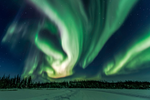
Yellowknife in Canada’s Northwest Territories is beneath the auroral oval, making it one of the best places for a Northern Lights vacation. The lights are visible up to 240 nights per year, with fall and winter being the main viewing seasons. Cold temperatures and clear, dark skies create the ideal canvas for the bright colours of the Canadian Aurora Borealis.
Best time to go: between November and April
Number of nights visible: up to 240 nights per year
Tours and daytime activities: Wildlife tours, fall-colour tours, dog-sledding, snowshoeing, museums, Indigenous story-telling and experiences, and art gallery tours.
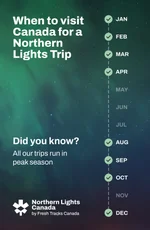
Popular Northern Lights Trip in Canada - 2024/25
Northern Lights of Churchill
Journey to Churchill, Manitoba—one of the top three places in the world to see the Northern Lights. During the dark, cold Arctic winter, cross the frozen Churchill River in a Tundra Buggy and watch the mystical Aurora in comfort. This Northern Lights trip features a culinary adventure under the stars, interpretive tours and guided winter activities.
Availability: February
Places Visited: Winnipeg and Churchill
Accommodation Style: Hotels
Activity Level: Easy
Northern Lights of the Yukon
This winter adventure in Whitehorse, Yukon, has four nights of Northern Lights viewing. The area’s low precipitation levels mean it is one of the best places to view Canada's aurora borealis. Enjoy a range of guided activities like dogsledding, snowshoeing, ice fishing or snowmobiling.
Availability: December to March
Places Visited: Vancouver and Whitehorse
Accommodation Style: Hotels
Activity Level: Easy
Add a Northern Lights Excursion to These Trips
Why not add a Northern Lights tour Canada to a winter train trip? The Yukon is just a couple of hours north of Vancouver or Calgary and is prime Northern Lights viewing territory. Some Canadian train trip itineraries that include Vancouver and/or the Canadian Rockies are:
Rockies Rail Winter Wonderland

Keep reading or chat with one of our local travel experts. We’re passionate about Canada and can help you at any stage of your vacation planning.
What Causes Northern Lights?
Understanding the science behind this light show can add to your experience of seeing the Northern Lights in Canada. The aurora borealis is actually caused by solar activity. The sun emits a continuous stream of charged particles known as solar wind. As these charged particles flow towards Earth, they are drawn towards the planet’s poles by its magnetic field. When the charged particles collide with gases in the Earth’s atmosphere — primarily oxygen and nitrogen — they release energy in the form of light, which becomes the aurora borealis.
The specific colours of the Northern Lights depend on which gas molecules are being excited and their altitude. Oxygen at higher altitudes (above 150 miles) produces red auroras, while oxygen at lower altitudes (up to 150 miles) produces the more common green lights. Nitrogen can result in rare blue or purple auroras.
Canada’s proximity to the magnetic north pole makes it one of the best places in the world to witness the Northern Lights. Regions such as Yukon, Northwest Territories, and parts of Manitoba and Alberta are particularly well-suited for aurora viewing — some are under the auroral oval, a recognized region of increased activity around the earth's poles. A combination of clear skies, minimal light pollution, and high geomagnetic activity ensures frequent and vivid displays.

Why Are the Northern Lights in Canada so Special?
Besides looking beautiful and being on many travelers’ wish lists, the Northern Lights are fascinating from a scientific point of view and have lots of cultural significance.
The lights are surrounded in many myths and legends across the world. For example, in Finnish folklore many people say the lights are created by the Arctic fox running through the snow. The country’s Sami people, however, believe the lights are the souls of the dead. In old Norse Viking legends, the lights were reflections bouncing off warriors’ armor.
In Canada, some Indigenous Peoples see the lights as sacred, regarding them as ancestral spirits dancing in the sky for the Great Spirit. For other groups, the lights are sky people playing ball, while others believe they are the spirits of those who passed in a difficult way. Many people speak hearing the lights, with crackling, sizzling, and hissing sounds. Some legends warn against attracting the attention of the lights because they can draw close and carry you away.
#2 Travel tip: Photography equipment
If you’re keen to capture photos of the Northern Lights, bring a tripod with you to keep your camera steady during longer exposure times.

Canadian Insider Tips to Experience Aurora Borealis
- The best way to see the Northern Lights is on a guided tour. A guide that knows the local area will check the Aurora forecast and take you to unique viewing locations.
- Be prepared to stay up late because the best time to view the Northern Lights is between 10pm and 2am, often around midnight. We suggest having a nap in the afternoon to compensate for these late nights!
- Tour guides on a Canada Northern Lights tour will take you to remote viewing locations that might be hard to reach on your own. Be ready to travel and wrap up warm.
- An advantage of joining a tour is that most providers offer winter gear rentals (if you do not own appropriate attire for the chilly Canadian temperatures).
- There’s no need to invest in and pack heavy winter coats and boots. Our guided tours include rental options that make it easy to stay warm and dry. Do bring clothing that is easy to layer.
- Northern Canada is home to many Indigenous nations. Add a local cultural experience to your trip, from visiting art galleries to organized activities from Dene story-telling tours to watching the aurora borealis in a teepee with a private guide.
- For the best chances of seeing the Northern Lights, visit in Fall or Winter. While you can sometimes spot the aurora borealis in some regions in summer, that season’s longer daylight hours reduce your viewing window.
More information on Northern Lights 2024/25 trips
Have questions about seeing the Northern lights in Canada and don’t see the answer here? Contact one of our travel experts to learn more about Northern lights vacation packages Canada.
Download a brochure
Get inspired with sample itineraries, train information, route maps, and travel advice from our local experts.
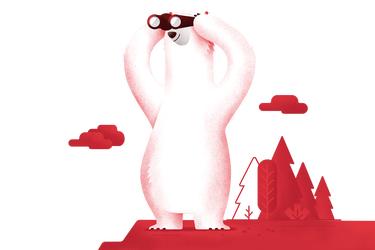
What Our Customers Say
Why book your train journey in Canada with Canadian Train Vacations?
We take care of all the details
You want to relax and enjoy your trip, not get overwhelmed by the planning. Let us make all of the bookings for you, including rail tickets, hotels, excursions and activities, meals and transfers.
Independent travel with expert support
Enjoy local expertise and guidance with a personalized itinerary. Your preferences and needs are our priority. We take care of you from the moment you land until the moment you leave.
Get help when you need it
You’ll receive the inside scoop before you even leave home. And you can relax during your vacation because we’re only a phone call away if you have any questions while you’re in Canada.
Frequently Asked Questions
What are northern lights?
The Northern Lights, also called Aurora Borealis, are waves of light that appear in the night sky in the Northern hemisphere. The lights appear near the magnetic poles. The same phenomenon occurs in the Southern hemisphere and is called the Southern Lights or Aurora Australis. Both light displays appear in various colours, including green (most common), yellow, pink, purple and red.
How much is a trip to see the northern lights?
Prices vary for Northern Lights Canada tours. Our Yukon packages start from $2,570 USD per person, while our Churchill packages start from $5,140 USD per person. Prices depend on travel dates, location, accommodation, and length of stay. Reach out to one of our Vacation Advisors for more information.
Is a northern lights tour worth it?
Seeing the Aurora Borealis Canada is a once-in-a-lifetime experience. A Northern Lights tour is worth it as it gives you the best chance of seeing the lights. Our Canadian Northern Lights tours include guided northern lights viewing, transportation and hotels.
How to capture northern lights on camera?
With the correct camera settings, you can capture the Northern Lights. If you are taking photos with your phone, use a slow shutter speed, switch to night mode, and set up a tripod to get the best Northern Lights images. A slow shutter speed is necessary because the lights move quickly.
About the author: Hannah Poaros-McDermott is the Senior Content Coordinator at Fresh Tracks Canada. She has previously written for and shared her local knowledge in Where Vancouver, Where Whistler, and Essential Vancouver magazines. Originally from the UK, Hannah travelled... Read more
Discuss your Canadian train vacation with a local travel expert
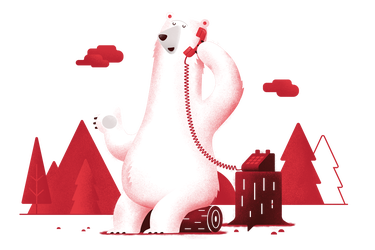
Current promotions
Sign up for special offers, monthly Canadian Insider tips, and vacation inspiration.
By submitting this form, you agree to our collection and use of your personal data as detailed in our Privacy Policy. Your information will be used to process your request and improve our services.
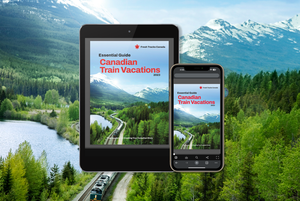
![Helen, Pedro, Kevin and Denise review of their [object Object] trip](https://cdn.bfldr.com/UAHFH8T4/as/4xh5n4jjpwwb479msx7h83v/Helen_Pedro_Kevin_Denise_388?auto=webp&format=webp&width=75)
![Jean review of their [object Object] trip](https://cdn.bfldr.com/UAHFH8T4/as/pwbmhf53v89k662fczfztn/Jean_383?auto=webp&format=webp&width=75)


